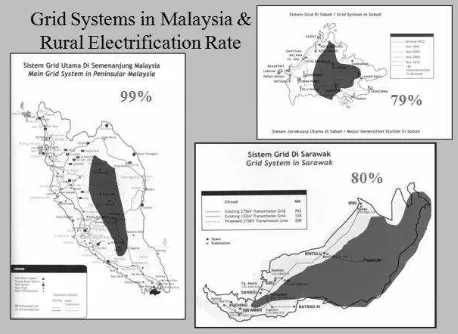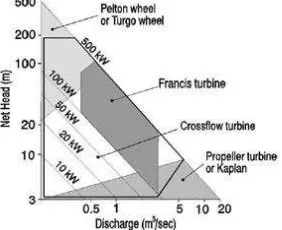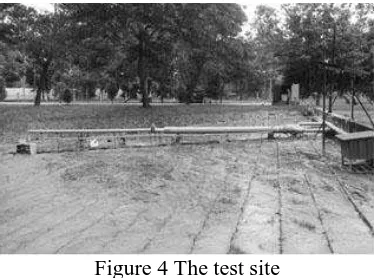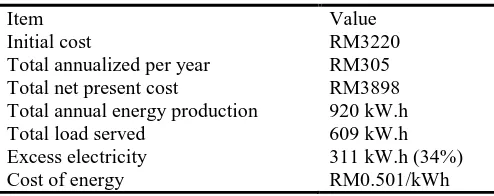Pico Hydro Application for Off-Grid Settlement
Juhari Ab Razak1*, Masjuri Musa1, Md Razali Ayob1, Muhammad Zahir Hassan1, Mohd Nizam Ab Rahman2, Kamaruzzaman Sopian3
1 Faculty of Mechanical Engineering, Universiti Teknikal Malaysia Melaka, Melaka, Malaysia 2 Faculty of Enginering and Built Environment, Universiti Kebangsaan Malaysia, Bangi, Selangor, Malaysia
3
Solar Energy Research Institute, Universiti Kebangsaan Malaysia, Bangi, Selangor, Malaysia
* Corresponding author: juhari@utem.edu.my
Abstract
Malaysia is currently constructing a large hydropower station with five more schemes under review. However these stations are catering for energy consuming industrial parks while the domestic supply is not making much in-road due to geographical constraints. This paper is discussing the use of off-grid alternative for power supply to the rural settlements. A run-of-river application, pico hydro, requires no dam or reservoir for water storage. It is intended for low flow and low head application. A mapping of possible locations for application along selected rivers in Malaysia is discussed. Two types of pico hydro turbine are selected for review and comparison in power production. Research are undertaken to promote this environment friendly technology to rural electrification program. Studies show that pico hydro manages to provide enough power for basic lighting needs in remote area where water is available with small drop or head.
Keywords: pico hydro, off-grid, run-of-river, turbine
1. Introduction
Asia leads the development in hydropower currently in progress with China, the number two energy user, planning to increase its capacity a further 190 GW [1]. These are referring to large-scale projects, from mini hydro (up to 1 MW), to small hydro (up to 10 MW) and to large hydropower plant, which has the capacity of more than 10 MW. Malaysia has the potential of 29000 MW of hydropower, especially in Sarawak and Sabah [2]. While the mega project provides a lot of power to the industrial parks, it failed to satisfy the needs of remote population domestically. These off-grid settlements are still depending on the generator sets for their lights and power. Until recently the rural electrification program reluctant to look at the capability of small-scale hydropower scheme despite the availability of potential sites that could benefit the rural community tremendously. As most villages are located near river, sites with low head (less than 10 m) are worth looking at for their potential [3]. Several renewable energy hybrid systems using small scale hydro were being tried at various locations of several countries. A project at Taratak Indonesia operated using a head of 5.5 m with a discharge rate of 240 l/s [4]. In Cameroon, a water turbine of 5 kW capacity making use of the available head of 10 m and flow rate of 92.6 l/s to provide 24 V DC system to light up their village [5]. The main problem of using this run-of-river application is the seasonal fluctuation of depth and flow rate of these rivers. The appropriate turbine should be chosen for the specific location depending on the available head and the minimum annual flow rate.
The 2400 MW Bakun hydroelectric project is initially targeted to provide the power to the peninsular Malaysia using underwater cable. However it has since being shelved due to the forecasted power needed by the industrial parks to be developed by the Sarawak state government and the potential of selling the electricity to Brunei and Indonesia. The state is also planning to build five smaller projects to meet future demand. The peninsular Malaysia also has large scale hydro plants ranging from 40 MW to 150 MW power. However, Malaysia has yet to fully utilize its many rivers, big or small, which are capable of producing electricity for domestic use especially to off-grid settlements living nearby. Fig. 1 shows grid systems in Malaysia and the rural electrification rate. The shaded area represents the geographical constraints where alternative for generator powered electrification program is required.
Figure 1 – Grid system in Malaysia and rural electrification rate, source: [9]
2. Methodology
Each potential site for small-scale hydropower scheme is considered unique due to its water head and the available flow rate. The turbine selection is based mostly on these criteria. Table 1 shows the flow rate of selected rivers at off-grid area. Even at low head these rivers have great potential of producing the required power for the remote areas. In most cases when the head is small the flow rate should be higher to get the same amount of power. The penstock and turbine should be designed to increase proportionally to support the increment [10]. The design of the turbine and the implementation methods need to be derived carefully to optimize the type of turbine to suit a particular location [11].
Table 1 Flow rate of selected rivers in off-grid area
River Min
(m3/s)
Mean (m3/s)
Max (m3/s)
Sg Muar 1.22 26.18 134.07
Sg Segamat 3.5 8 41
Sg Serting 1.81 6.28 28.73
Sg Triang 6.4 19.91 59.76
Sg Pahang 149.1 356.3 2651.5 Sg Lipis 68.92 69.57 72.39
Sg Jelai 150.96 216.28 717.28 Sg Tembeling 62.49 179.19 1916.09
Sg Galas 505.9 735.9 2355.6
Sg Pergau 23.1 75.1 233
There are two types of turbines to be considered, impulse and reaction turbines. In most cases impulse turbines are used for high head sites, and reaction turbines are used for low head sites. Impulse turbine is embedded in the fluid and powered from the pressure drop across the device. Reaction turbines operate with the flow hits the turbine as a jet in an open environment, with the power deriving from the kinetic energy. Table 2 shows the types of impulse and reaction turbines used at high, medium and low head.
Table 2 Types of turbine for small hydro application based on available head
Turbine High
(H>50m)
Medium (50m<M>10m)
Low (10m>L)
Impulse Pelton
Turgo
Crossflow
Reaction Francis
Kaplan
Propeller
While pelton wheels could also be used for low head hydro systems [12][13], using Kaplan or Francis turbines at high initial capital cost in hydro system with small head and modest flow rate will lead to design problem. Montanari [14] suggested that either propeller or crossflow turbine could be used due to their costs and potential power produced. Fig. 2 [8] shows the range of suitability of various types of turbines based on the flow rate and net head. Propeller, Kaplan and crossflow turbines are suitable for low head low flow applications. Crossflow turbine has significant advantages over other turbines if the flow rate varies a lot during seasonal variations.
Figure 2 Suitability of turbine based on flow rate and net head [8]
Propeller and crossflow turbines, as shown in Fig. 3, are selected for testing for low flow and low head application. The pico hydro scheme is intended to provide up to 1 kW off-grid power for rural application. The propeller turbine is imported from Australia at a cost of RM10,000.00 and the crossflow turbine is fabricated locally for RM2,500.00
The test site is located at Universiti Kebangsaan Malaysia at Bangi. Water is derived from the natural pond near the Faculty of Engineering and Built Environment using penstock made of hard PVC pipe of 150 mm inside diameter. The head is about 1.2 m and flow rate is between 20-25 L/s.
Figure 4 The test site
3. Results
The propeller turbine produces voltage between 80 and 140 V, and AC current between 70 and 330 mA. The mean depth of water in the water chamber is 14 cm. Results in Table 3 shows the maximum power produced by the turbine using several light bulbs as the loading. The current is too small so the output power falls below 50 W.
Table 3 The maximum power produced at 14 cm water depth
Bulb minimum revolution to charge the battery the right gear ratio is required. Experiment data, as shown in Table 4, indicates the gear ratio of 12:108 (alternator:turbine) provides the best output with enough power to charge the battery. The alternator produces a maximum of 15.25 V in 12 V DC system with at least 13 V for charging the system. The power produced by 12:70 gear ratio is enough to light-up the system directly without the charging process. The maximum power is expected to reach 100 W when the head is at 1.2 m with flow rate of 25 L/s.
Table 4. Power generation by gear ratio
Ratio Voltage (V) Current (A)
12:50 9.50 3.10
12:70 11.20 3.74
12:108 15.25 4.52
The power output can only be raised by increasing the head and by having higher flow rate. Increasing the head means extending the penstock and placed the turbine further down the steps. It is no longer possible to increase the gear ratio higher than 12:108 due to too much torque exerted to the small gear connected to the alternator. This could lead to more vibration on the alternator set-up and possibility of the connecting shaft to the small to be broken.
critical value is cost of energy (COE) is RM0.501/kWh, which is reasonable when compared to the tariff set by the government at the minimum of RM0.218/kWh and maximum of RM0.460/kWh.
Table 5 Cost and energy production for pico hydro turbine
Item Value
Initial cost RM3220
Total annualized per year RM305
Total net present cost RM3898
Total annual energy production 920 kW.h
Total load served 609 kW.h
Excess electricity 311 kW.h (34%)
Cost of energy RM0.501/kWh
4. Conclusions
The propeller turbine produces too low current to make it useful for domestic use. The cost of turbine is too high due to it has to be imported. Imported turbine will be subjected to taxes, cost of maintenance and non existence technology transfer. Maintenance would be a problem if the turbine breaks down. One of the advantages of the crossflow turbine is that it can be fabricated locally. The maintenance and repair can be done by the local people, meaning the actual total cost will be kept relatively low. Due to the uniqueness of each site the power potential of the location and the selection of suitable turbine which is based on the head and flow rate of the water. As shown in Table 1 there is large variation of flow rate due to seasonal change. Crossflow turbine is suitable for low head application and most preferable when the great fluctuation of the flow rate as it has higher efficiency at low ratio of turbine flow to design flow compared to propeller turbine.
At location where water flow is available pico hydro turbine system is the cheapest available renewable energy system. Solar module scheme can only be functional during daylight. At night it depends entirely on battery system. Its initial high capital cost becomes a barrier for development of rural electrification program. In order to provide the same amount of power produce by hydro, solar module scheme needs to increase its sizing double or triple, thus increase its total cost. Generator set needs to be operated continuously to provide electricity around the clock. This will cost three times as much compared to pico hydro scheme. This is based on the high cost of fuel due to transportation cost to this hard to access location. Furthermore the generator will need to be replaced after accumulating certain number of operating hours due to maintenance and efficiency reasons. Wind in Malaysia is not a main source renewable energy. At most times it is too small to generate any power for domestic use. The potential locations are near the coastal areas. As the main target for off-grid electrification program is the shaded area in Fig. 1 wind turbine will not be an option.
Correct sizing of components is important since oversizing means overproducing the required power. High excess energy leads to high COE. Steps need to be taken to minimize the excess energy while optimizing the system. Using a single component usually leads to oversizing. A hybrid system, which requires optimization, could reduce the probability of having high excess energy. As shown in Fig. 3, works currently are undertaken to incorporate the pico hydro, PV panels and wind charger as a hybrid renewable energy system, and generator as a back-up to charge the battery. Instead of using the battery as storage, it is used to supply DC current to provide electricity to off-grid community. All three renewable components and generator are designed to charge the battery set to provide enough power to meet the demand load. Based on the loading optimum sizing of each of the hybrid components and suitable operation strategy for each optimum combination will be decided.
Acknowledgment
5. References
[1] A. Bartle (2002) Hydropower potential and development activities, Energy Policy 30, pp. 1231-123.
[2] N.W.A. Lidula, N. Mithulananthan, W. Ongsakul, C. Widjaya and R. Henson (2007) ASEAN towards clean and sustainable energy: Potentials, utilization and barriers, Renewable Energy 32 (9), pp. 1441-1452.
[3] A.K.M. Sadrul Islam, M.Q. Islam, M.Z. Hossain, M.I. Khan and S.A. Uddin (2002) Appropriate low head micro hydro systems for Bangladesh, Proceedings of Second International Conference on Electrical and Computer Engineering, Dhaka, Bangladesh, 26-28 December, pp. 216-219
[4] R. Muhida, A. Mustavan, W. Sujatmiko, M. Park and K. Matsuura (2001) The 10 years operation of a PV-micro-hydro hybrid system in Taratak, Indonesia, Solar Energy Materials & Solar Cells 67, pp. 621-627. [5] E.M. Nfah and J.M. Ngundam (2009) Feasibility of pico-hydro and photovoltaic hybrid power systems for remote villages in Cameroon, Renewable Energy 34, pp. 1445–1450.
[6] P. Maher, N.P.A. Smith and A.A. Williams (2003) Assessment of pico hydro as an option for off-grid electrification in Kenya, Renewable Energy 28 (9), pp. 1357-1369.
[7] V. Nunes and J. Genta (1996) Micro and mini hydroelectric power assessment in Uruguay, Renewable Energy 9 (1-4), pp. 1235-1238.
[8] O. Paish (2002) Small hydro power: technology and current status, Renewable and Sustainable Energy Reviews 6 (6), pp. 537-556.
[9] A. Kasbani, 2006. EEG presentation to ETOG.25Aug2005, Malaysia REP-PoR 27-28 April 2006, http://regionalcentrebangkok.undp.or.th/practices/energy_env/documents/meeting report/march 20meeting/ Malaysia REP-PoR 27-28 April 2006.ppt. [accessed on 13 June 2010].
[10] K.V. Alexander, E.P. Giddens and A.M. Fuller (2009) Axial-flow turbines for low head microhydro systems, Renewable Energy 34, pp. 35-47.
[11] A.A. Williams and R. Simpson (2009) Pico hydro – reducing technical risks for rural electrification, Renewable Energy 34 (8), pp. 1986-1991.
[12] K.V. Alexander and E.P. Giddens (2008) Optimum penstocks for low head microhydro schemes, Renewable Energy 33 (3), pp. 507-519.
[13] K.V. Alexander and E.P. Giddens (2008) Microhydro: cost-effective, modular systems for low heads, Renewable Energy 33(6), pp. 1379-1391.



